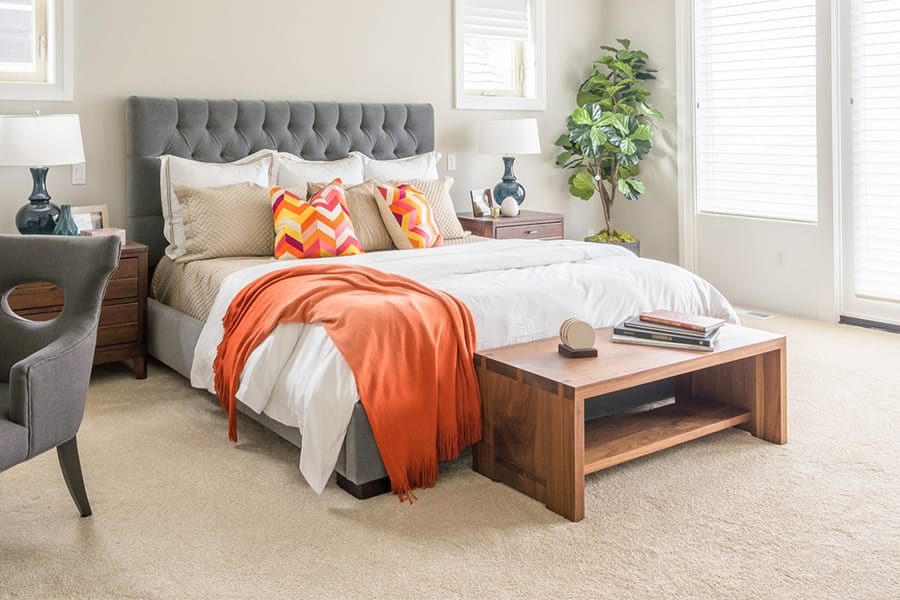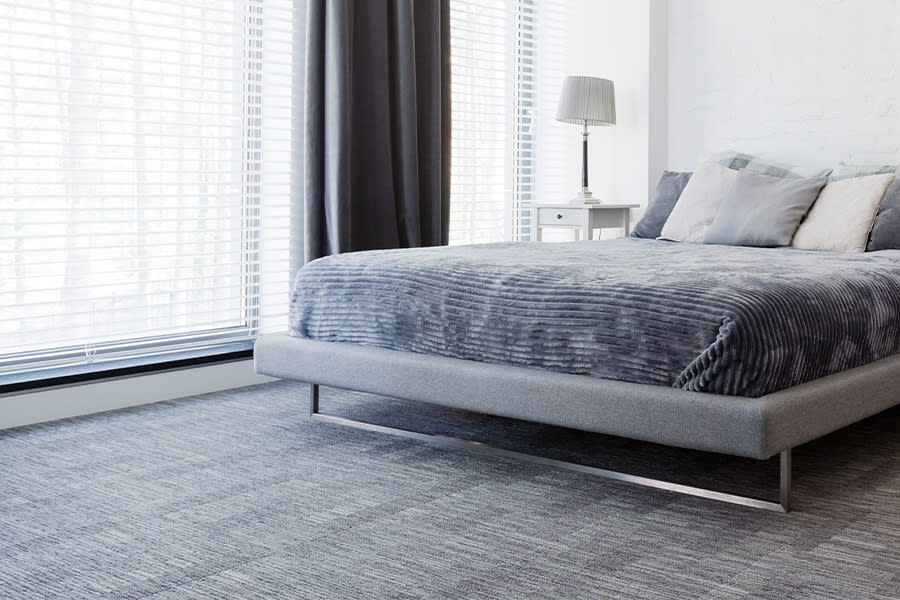About carpet
Widely considered one of the easiest and most transformational upgrades you can do to your home, carpet flooring enjoys broad appeal for its diversity, cushioning and warmth. Available in a wide variety of colors, patterns and textures, perhaps the two most important considerations when choosing carpet are the type of fiber used and the pile, as these determine the overall comfort and wear characteristics of all carpet.
Carpet fibers
There a numerous natural and synthetic fibers used in carpet manufacturing. The most common fibers are nylon, polypropylene (Olefin), polyester, acrylic and wool. Nylon is the most popular by far, but each fiber has its own unique properties and characteristics to consider.
Soft, durable and resistant to stains and abrasion, this synthetic fiber is easy to dye and holds color well. It has good resistance to wear, mold, mildew, and rot, and can last for 12-15 years. While not the least expensive option, it’s usually affordably priced. Cost ***
Typically used in commercial environments this popular fiber is nearly as soft as nylon and commonly used for loop-style carpets like Berbers. Similar to natural wool and often used as a synthetic substitute, Olefin fibers are highly stain-resistant and gaining traction in residential settings. Prone to soiling and holding onto oils, they collect dirt and requiring more regular cleaning. Cost **
Prized for its ability to hold vibrant color, this man-made fiber is fade-resistant and more hypoallergenic than most. One type of polyester, known as PET, is made from recycled plastic bottles making this fiber an eco-friendly choice. Prone to flattening and oil stains it is a bad choice for high-traffic areas.
This fiber offers the look and feel of real wool at a fraction of the price. It has good resistance to staining, fading, moisture, milder and static electricity, but it doesn’t hold up well to high traffic areas.
Extremely expensive, this natural, long-lasting fiber is the softest and most luxurious you can find but is prone to damage from mold and mildew. It is often combined with synthetic fibers like acrylic to deliver the benefits of both, but not recommended for areas with high humidity and moisture. Cost *****
Nylon
Soft, durable and resistant to stains and abrasion, this synthetic fiber is easy to dye and holds color well. It has good resistance to wear, mold, mildew, and rot, and can last for 12-15 years. While not the least expensive option, it’s usually affordably priced. Cost ***
Polypropylene (Olefin)
Typically used in commercial environments this popular fiber is nearly as soft as nylon and commonly used for loop-style carpets like Berbers. Similar to natural wool and often used as a synthetic substitute, Olefin fibers are highly stain-resistant and gaining traction in residential settings. Prone to soiling and holding onto oils, they collect dirt and requiring more regular cleaning. Cost **
Polyester
Prized for its ability to hold vibrant color, this man-made fiber is fade-resistant and more hypoallergenic than most. One type of polyester, known as PET, is made from recycled plastic bottles making this fiber an eco-friendly choice. Prone to flattening and oil stains it is a bad choice for high-traffic areas.
Acrylic
This fiber offers the look and feel of real wool at a fraction of the price. It has good resistance to staining, fading, moisture, milder and static electricity, but it doesn’t hold up well to high traffic areas.
Wool
Extremely expensive, this natural, long-lasting fiber is the softest and most luxurious you can find but is prone to damage from mold and mildew. It is often combined with synthetic fibers like acrylic to deliver the benefits of both, but not recommended for areas with high humidity and moisture. Cost *****
Request A Consultation
Carpet Pile Cuts
Carpets are made by tufting or looping fiber yarns through a backing material, and how they’re attached to that backing is called pile. The loops can be left alone or cut at various lengths and angles, impacting the look, comfort and wear characteristics. Loop pile and cut pile are the most popular carpet types, but saxony, plush, textured, frieze, and sculpted pile offer limitless options for commercial and consumer applications as well.
Loop pile, widely known as Berber, leaves the fiber yarn loops intact, making them highly durable, easy to clean and resistant to stains. They are ideal for commercial and high-traffic areas.
Cut pile is a style of carpet that is sheared, exposing the ends of the carpet fiber. Generally softer to the touch and softer under foot than loop, cut pile carpeting is ideal for residential spaces. When selecting cut pile, take a close look at the fiber twist. The twist helps it stand up and resist matting and crushing and the tighter the twist, the more durable your carpet will be.
Want to learn more? Check out Understanding Carpet Fiber and Pile Cuts by Joseph Lewitin for The Spruce.
Loop pile, widely known as Berber, leaves the fiber yarn loops intact, making them highly durable, easy to clean and resistant to stains. They are ideal for commercial and high-traffic areas.
Cut pile is a style of carpet that is sheared, exposing the ends of the carpet fiber. Generally softer to the touch and softer under foot than loop, cut pile carpeting is ideal for residential spaces. When selecting cut pile, take a close look at the fiber twist. The twist helps it stand up and resist matting and crushing and the tighter the twist, the more durable your carpet will be.
Want to learn more? Check out Understanding Carpet Fiber and Pile Cuts by Joseph Lewitin for The Spruce.
Carpet Padding
As the foundation for your carpet, padding is another important consideration. It protects your carpet from damage by keeping the carpet backing from breaking down against the subfloor. It also contributes to overall comfort and how your carpet feels under-foot. Padding also provides excellent insulation and sound dampening properties, making your home warmer, quieter and more energy efficient.
Typically made from foam, rubber, or fiber, padding is sold in a variety of densities, with higher densities offering better performance. Padding made from natural materials like Jute or Latex will appeal to some, but urethane foams dominate the market. The most common padding is bonded urethane, an environmentally responsible option made from recycled foam scraps fused with heat and glue. Many of today’s better pads also incorporate a moisture barrier or membrane offering added protection for potentially wet or damp environments lake basements.
Carpet enjoys numerous benefits making it the number one flooring choice for businesses and consumers. Here are the top six reasons carpet is the number one choice according to CRI, the Carpet and Rug Institute.
Safety: First and foremost, a carpeted floor is a safer floor. The soft surface and cushioned under-padding not only reduce the impact of a fall, but also the likelihood of it happening in the first place. Carpet is inherently slip-resistant, meaning it’s harder to slip and fall.
Sound Reduction : If you live in a busy home with lots of traffic, you know how loud wood or laminate floors can be. Carpet stifles noise and reduces echoes in three ways; absorbing the impact of foot traffic, soaking up room sounds and echoes and finally, by blocking sound from carrying between floors (especially helpful in condo apartments or multi-family homes).
Warmth & Insulation : Carpet provides excellent warmth underfoot, making it a great choice for chilly bedrooms or stark offices. Carpet also acts as an insulator. The combination of the carpet and its under-padding acts as an additional layer of insulation in your home and – depending on the weight and grade of your carpet – it can even add to the R-value of your home.
Ease of Care : Most carpets made today are made to be highly stain-resistant, meaning cleanup is easy. With just a damp cloth or a quick vacuuming, your floors look as good as new. Because carpets trap dust and allergens, they can also improve the air quality in your home as long they’re properly cleaned and vacuumed on a regular basis.
Flexibility and Style: Carpet isn’t limited to just a few colors or grains. You can get carpet in any style, design, color or pattern that you want. Because of its versatility, carpet fits in well in any design scheme.
Value: Low Cost : Typically, carpet costs significantly less than other types of flooring like tile, marble or hardwood. Even with professional installation, carpet tends to cost much less than other types of flooring options.
Typically made from foam, rubber, or fiber, padding is sold in a variety of densities, with higher densities offering better performance. Padding made from natural materials like Jute or Latex will appeal to some, but urethane foams dominate the market. The most common padding is bonded urethane, an environmentally responsible option made from recycled foam scraps fused with heat and glue. Many of today’s better pads also incorporate a moisture barrier or membrane offering added protection for potentially wet or damp environments lake basements.
Benefits of Carpet
Carpet enjoys numerous benefits making it the number one flooring choice for businesses and consumers. Here are the top six reasons carpet is the number one choice according to CRI, the Carpet and Rug Institute.
Safety: First and foremost, a carpeted floor is a safer floor. The soft surface and cushioned under-padding not only reduce the impact of a fall, but also the likelihood of it happening in the first place. Carpet is inherently slip-resistant, meaning it’s harder to slip and fall.
Sound Reduction : If you live in a busy home with lots of traffic, you know how loud wood or laminate floors can be. Carpet stifles noise and reduces echoes in three ways; absorbing the impact of foot traffic, soaking up room sounds and echoes and finally, by blocking sound from carrying between floors (especially helpful in condo apartments or multi-family homes).
Warmth & Insulation : Carpet provides excellent warmth underfoot, making it a great choice for chilly bedrooms or stark offices. Carpet also acts as an insulator. The combination of the carpet and its under-padding acts as an additional layer of insulation in your home and – depending on the weight and grade of your carpet – it can even add to the R-value of your home.
Ease of Care : Most carpets made today are made to be highly stain-resistant, meaning cleanup is easy. With just a damp cloth or a quick vacuuming, your floors look as good as new. Because carpets trap dust and allergens, they can also improve the air quality in your home as long they’re properly cleaned and vacuumed on a regular basis.
Flexibility and Style: Carpet isn’t limited to just a few colors or grains. You can get carpet in any style, design, color or pattern that you want. Because of its versatility, carpet fits in well in any design scheme.
Value: Low Cost : Typically, carpet costs significantly less than other types of flooring like tile, marble or hardwood. Even with professional installation, carpet tends to cost much less than other types of flooring options.

Mach + Rico Project Pricing Includes:
Onsite designer to assist with design and material selection. Schluter Systems® integrated products for watertight installation. Grout from TEC, Custom, and Mapei.
Sealers for natural stone products.
Ceramic, porcelain, terracotta, glass, metal, and natural stone tile from Mosaic Tile (Atlas Concorde, Roca, and Crossville), Daltile, Marazzi, Emser Tile, TileBar, MSI, Conestoga Tile (Florida Tile, Milestone, and Lungarno), Marble Systems, Floor & Décor, Architessa, Tile Shop, Porcelanosa, and more.
Sealers for natural stone products.
Ceramic, porcelain, terracotta, glass, metal, and natural stone tile from Mosaic Tile (Atlas Concorde, Roca, and Crossville), Daltile, Marazzi, Emser Tile, TileBar, MSI, Conestoga Tile (Florida Tile, Milestone, and Lungarno), Marble Systems, Floor & Décor, Architessa, Tile Shop, Porcelanosa, and more.








